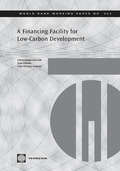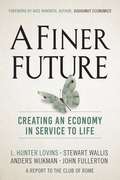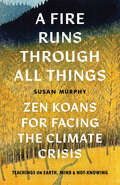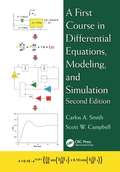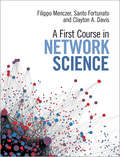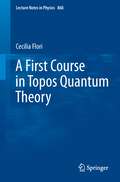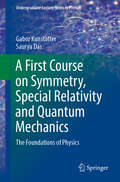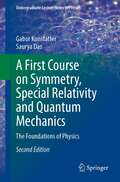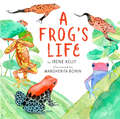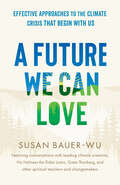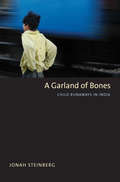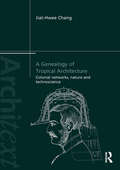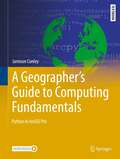- Table View
- List View
A Fierce Green Fire: The American Environmental Movement
by Philip ShabecoffIn A Fierce Green Fire, renowned environmental journalist Philip Shabecoff presents the definitive history of American environmentalism from the earliest days of the republic to the present. He offers a sweeping overview of the contemporary environmental movement and the political, economic, social, and ethical forces that have shaped it. More importantly, he considers what today's environmental movement needs to do to fight off powerful oppositional forces and succeed in its mission of protecting the American people, their habitat, and their future.Shabecoff traces the ecological transformation of North America as a result of the mass migration of Europeans to the New World, showing how the environmental impulse slowly formed among a growing number of Americans until, by the last third of the 20th Century, environmentalism emerged as a major social and cultural movement. He examines the efforts of key environmental figures -- among them Henry David Thoreau, Theodore Roosevelt, Aldo Leopold, and Rachel Carson -- as well as the activities of non-governmental environmental groups, government agencies such as the EPA and Interior Department, and grassroots efforts by communities across America.Originally published in 1993, this new edition brings the story up to date with an analysis of how the of George W. Bush administration sought to dismantle a half-century of progress in protecting the land and its people, and a consideration of the growing international effort to protect Earth's life-support systems and the obstacles the United States government is placing before that effort.Now, when environmental law, institutions, and values are under increased attack and opponents of environmentalism are enjoying overwhelming political and economic power A Fierce Green Fire is a vital reminder of how far we have come in protecting our environment and how much we have to lose.
A Financing Facility for Low-Carbon Development in Developing Countries
by Philippe Ambrosi Ivan ZelenkoThis paper proposes an innovative financing mechanism, known as the Low Carbon Development Facility (LCDF) that would bring additional investment financing at concessional rates to unlock low carbon development projects in non-Annex 1 countries, increasing project-based emissions avoidance in these countries. The LCDF could be a modality of the Copenhagen Green Climate Fund to implement the financial pledges made by Annex 1 countries as a result of Copenhagen and post-COP15 negotiations to support projects, programs, policies and/or other activities in developing countries related to NAMAs. LCDF will not substitute the Global Environment Facility (GEF) and the Clean Technology Fund (CTF) and would rather support the innovative projects pioneered by these instruments.
A Finer Future: Creating an Economy in Service to Life
by John Fullerton Kate Raworth Anders Wijkman L. Lovins Stewart WallisHUMANITY is in a race with catastrophe. Is the future one of global warming, 65 million migrants fleeing failed states, soaring inequality, and grid-locked politics? Or one of empowered entrepreneurs and innovators building a world that works for everyone? <P><P>While the specter of collapse looms large, A Finer Future demonstrates that humanity has a chance - just - to thread the needle of sustainability and build a regenerative economy through a powerful combination of enlightened entrepreneurialism, technology, and innovative policy. <P><P>The authors - world leaders in business, economics, and sustainability - gather the evidence, outline the principles of a regenerative economy, and detail a policy roadmap to achieving it, including: <P><P>Transforming finance and corporations Reimagining energy, agriculture, and the nature of how we work, Enhancing human well-being, Delivering a world that respects ecosystems and human community. <P><P>Charting the course to a regenerative economy is the most important work facing humanity and A Finer Future provides the essential blueprint for business leaders, entrepreneurs, environmentalists, politicians, policymakers, and others working to create a world that works for people and the planet. L. HUNTER LOVINS is Time Magazine's Millennium Hero for the Planet, President and Founder of Natural Capitalism Solutions, and co-author of The Way Out and the best-selling Natural Capitalism. STEWART WALLIS is Executive Chair of the Wellbeing Economy Alliance; Honorary Professor at Lancaster University; and former Executive Director of the New Economics Foundation. He now leads a new initiative to create a global wellbeing economic movement. ANDERS WIJKMAN is Co-President of the Club of Rome; Chair of Climate-KIC, the largest publicprivate partnership for climate innovation in the EU; and author of Bankrupting Nature and Come On! JOHN FULLERTON is founder and President of Capital Institute, and a former Managing Director at JP Morgan. He is also the author of Regenerative Capitalism: How Universal Principles and Patterns Will Shape our New Economy .
A Fire Runs through All Things: Zen Koans for Facing the Climate Crisis
by Susan MurphyAt a time of climate emergency, Zen koans show us how crisis itself can reveal the regenerative openness of life, mind, and being.Zen koans are a tradition of holistic inquiry based on &“encounter stories&” from East Asia&’s most radical Buddhist tradition. Turning this form of inquiry toward the climate crisis, Susan Murphy contends that koans can help us enter the mind of not-knowing, from which acceptance and possibility freely emerge. Koans reveal intimate, mythic, artful, playful, provocative, humorous, and fierce ways to engage the work of protecting and healing our world.The koans point firstly at ourselves—at the very nature of "self." Until we hold &“self&” as a live question rather than its own unquestioned answer, we&’re stuck looking on from the &“outside,&” hoping to engineer change upon a problem called &“climate crisis,&” all the time oblivious to the fact that we&’re swimming in a reality with no outside to it, an ocean of transformative energy. Do we dare relinquish our wish for absolute control and fearlessly surf the intensity of our feelings about the suffering earth?In addition to her use of dozens of traditional and new koans, Murphy illuminates the little-known Zen resonance with the oldest continuous body of indigenous wisdom on earth, summed up in the subtle Australian Aboriginal word Country. Murphy draws from her study and coteaching with Uncle Max (Dulumunmun) Harrison, a distinguished Yuin Elder, to show how this millennia-deep taproot of intelligence confirms the aliveness of the earth and the kinship of all beings.
A First Course in Differential Equations, Modeling, and Simulation
by Carlos A. Smith Scott W. CampbellA First Course in Differential Equations, Modeling, and Simulation shows how differential equations arise from applying basic physical principles and experimental observations to engineering systems. Avoiding overly theoretical explanations, the textbook also discusses classical and Laplace transform methods for obtaining the analytical solution of
A First Course in Mathematical Physics
by Colm T. WhelanThe book assumes next to no prior knowledge of the topic. The first part introduces the core mathematics, always in conjunction with the physical context. In the second part of the book, a series of examples showcases some of the more conceptually advanced areas of physics, the presentation of which draws on the developments in the first part. A large number of problems helps students to hone their skills in using the presented mathematical methods. Solutions to the problems are available to instructors on an associated password-protected website for lecturers.
A First Course in Network Science
by Filippo Menczer Santo Fortunato Clayton A. DavisNetworks are everywhere: networks of friends, transportation networks and the Web. Neurons in our brains and proteins within our bodies form networks that determine our intelligence and survival. This modern, accessible textbook introduces the basics of network science for a wide range of job sectors from management to marketing, from biology to engineering, and from neuroscience to the social sciences. Students will develop important, practical skills and learn to write code for using networks in their areas of interest - even as they are just learning to program with Python. Extensive sets of tutorials and homework problems provide plenty of hands-on practice and longer programming tutorials online further enhance students' programming skills. This intuitive and direct approach makes the book ideal for a first course, aimed at a wide audience without a strong background in mathematics or computing but with a desire to learn the fundamentals and applications of network science.
A First Course in Ordinary Differential Equations: Analytical and Numerical Methods
by Martin Hermann Masoud SaraviThis book presents a modern introduction to analytical and numerical techniques for solving ordinary differential equations (ODEs). Contrary to the traditional format--the theorem-and-proof format--the book is focusing on analytical and numerical methods. The book supplies a variety of problems and examples, ranging from the elementary to the advanced level, to introduce and study the mathematics of ODEs. The analytical part of the book deals with solution techniques for scalar first-order and second-order linear ODEs, and systems of linear ODEs--with a special focus on the Laplace transform, operator techniques and power series solutions. In the numerical part, theoretical and practical aspects of Runge-Kutta methods for solving initial-value problems and shooting methods for linear two-point boundary-value problems are considered. The book is intended as a primary text for courses on the theory of ODEs and numerical treatment of ODEs for advanced undergraduate and early graduate students. It is assumed that the reader has a basic grasp of elementary calculus, in particular methods of integration, and of numerical analysis. Physicists, chemists, biologists, computer scientists and engineers whose work involves solving ODEs will also find the book useful as a reference work and tool for independent study. The book has been prepared within the framework of a German-Iranian research project on mathematical methods for ODEs, which was started in early 2012.
A First Course in Random Matrix Theory: for Physicists, Engineers and Data Scientists
by Jean-Philippe Bouchaud Marc PottersThe real world is perceived and broken down as data, models and algorithms in the eyes of physicists and engineers. Data is noisy by nature and classical statistical tools have so far been successful in dealing with relatively smaller levels of randomness. The recent emergence of Big Data and the required computing power to analyse them have rendered classical tools outdated and insufficient. Tools such as random matrix theory and the study of large sample covariance matrices can efficiently process these big data sets and help make sense of modern, deep learning algorithms. Presenting an introductory calculus course for random matrices, the book focusses on modern concepts in matrix theory, generalising the standard concept of probabilistic independence to non-commuting random variables. Concretely worked out examples and applications to financial engineering and portfolio construction make this unique book an essential tool for physicists, engineers, data analysts, and economists.
A First Course in Topos Quantum Theory (Lecture Notes in Physics #868)
by Cecilia FloriIn the last five decades various attempts to formulate theories of quantum gravity have been made, but none has fully succeeded in becoming the quantum theory of gravity. One possible explanation for this failure might be the unresolved fundamental issues in quantum theory as it stands now. Indeed, most approaches to quantum gravity adopt standard quantum theory as their starting point, with the hope that the theory's unresolved issues will get solved along the way. However, these fundamental issues may need to be solved before attempting to define a quantum theory of gravity. The present text adopts this point of view, addressing the following basic questions: What are the main conceptual issues in quantum theory? How can these issues be solved within a new theoretical framework of quantum theory? A possible way to overcome critical issues in present-day quantum physics - such as a priori assumptions about space and time that are not compatible with a theory of quantum gravity, and the impossibility of talking about systems without reference to an external observer - is through a reformulation of quantum theory in terms of a different mathematical framework called topos theory. This course-tested primer sets out to explain to graduate students and newcomers to the field alike, the reasons for choosing topos theory to resolve the above-mentioned issues and how it brings quantum physics back to looking more like a "neo-realist" classical physics theory again.
A First Course on Symmetry, Special Relativity and Quantum Mechanics: The Foundations of Physics (Undergraduate Lecture Notes in Physics)
by Gabor Kunstatter Saurya DasThis book provides an in-depth and accessible description of special relativity and quantum mechanics which together form the foundation of 21st century physics. A novel aspect is that symmetry is given its rightful prominence as an integral part of this foundation. The book offers not only a conceptual understanding of symmetry, but also the mathematical tools necessary for quantitative analysis. As such, it provides a valuable precursor to more focused, advanced books on special relativity or quantum mechanics.Students are introduced to several topics not typically covered until much later in their education.These include space-time diagrams, the action principle, a proof of Noether's theorem, Lorentz vectors and tensors, symmetry breaking and general relativity. The book also provides extensive descriptions on topics of current general interest such as gravitational waves, cosmology, Bell's theorem, entanglement and quantum computing.Throughout the text, every opportunity is taken to emphasize the intimate connection between physics, symmetry and mathematics.The style remains light despite the rigorous and intensive content. The book is intended as a stand-alone or supplementary physics text for a one or two semester course for students who have completed an introductory calculus course and a first-year physics course that includes Newtonian mechanics and some electrostatics. Basic knowledge of linear algebra is useful but not essential, as all requisite mathematical background is provided either in the body of the text or in the Appendices. Interspersed through the text are well over a hundred worked examples and unsolved exercises for the student.
A First Course on Symmetry, Special Relativity and Quantum Mechanics: The Foundations of Physics (Undergraduate Lecture Notes in Physics)
by Gabor Kunstatter Saurya DasThis book provides an in-depth and accessible description of special relativity and quantum mechanics which together form the foundation of 21st century physics. A novel aspect is that symmetry is given its rightful prominence as an integral part of this foundation. The book offers not only a conceptual understanding of symmetry, but also the mathematical tools necessary for quantitative analysis. As such, it provides a valuable precursor to more focused, advanced books on special relativity or quantum mechanics.Students are introduced to several topics not typically covered until much later in their education.These include space-time diagrams, the action principle, a proof of Noether's theorem, Lorentz vectors and tensors, symmetry breaking and general relativity. The book also provides extensive descriptions on topics of current general interest such as gravitational waves, cosmology, Bell's theorem, entanglement and quantum computing.Throughout the text, every opportunity is taken to emphasize the intimate connection between physics, symmetry and mathematics.The style remains light despite the rigorous and intensive content. The book is intended as a stand-alone or supplementary physics text for a one or two semester course for students who have completed an introductory calculus course and a first-year physics course that includes Newtonian mechanics and some electrostatics. Basic knowledge of linear algebra is useful but not essential, as all requisite mathematical background is provided either in the body of the text or in the Appendices. Interspersed through the text are well over a hundred worked examples and unsolved exercises for the student.
A First Introduction to Quantum Physics (Undergraduate Lecture Notes in Physics)
by Pieter KokIn this undergraduate textbook, the author develops the quantum theory from first principles based on very simple experiments: a photon travelling through beam splitters to detectors, an electron moving through a Stern-Gerlach machine, and an atom emitting radiation. From the physical description of these experiments follows a natural mathematical description in terms of matrices and complex numbers. The first part of the book examines how experimental facts force us to let go of some deeply held preconceptions and develops this idea into a mathematical description of states, probabilities, observables, and time evolution using physical applications. The second part of the book explores more advanced topics, including the concept of entanglement, the process of decoherence, and extension of the quantum theory to the situation of a particle in a one-dimensional box. Here, the text makes contact with more traditional treatments of quantum mechanics. The remaining chapters delve deeply into the idea of uncertainty relations and explore what the quantum theory says about the nature of reality. The book is an ideal and accessible introduction to quantum physics, with modern examples and helpful end-of-chapter exercises.
A Flora of Southern California
by Philip A. MunzThis title is part of UC Press's Voices Revived program, which commemorates University of California Press’s mission to seek out and cultivate the brightest minds and give them voice, reach, and impact. Drawing on a backlist dating to 1893, Voices Revived makes high-quality, peer-reviewed scholarship accessible once again using print-on-demand technology. This title was originally published in 1974.
A Flower Garden for Pollinators: Learn how to sustain and support nature with this practical planting guide
by Rachel de ThameThe perfect guide for any gardener looking for inspiration on how to create a pollinator-friendly garden all year round.Pollinators are essential to life on Earth. Yet bees, butterflies and other beneficial insects are struggling due to climate change and habit loss. Fortunately, what we choose to plant in our gardens can help them to thrive. In this heartfelt guide, horticulturalist and Gardener's World presenter Rachel de Thame highlights plants we can grow that are rich in nectar and pollen, ensuring the garden is filled with beautiful flowers for us all to enjoy year-round.Arranged by season and illustrated with exquisite hand-painted watercolours and glorious photography showcasing many of Rachel's favourite plants, this book provides a captivating look at how best to support nature. Whether you have a small urban courtyard or a large country garden, A Flower Garden for Pollinators will guide your choice of plants, attracting a host of pollinators to your own patch of paradise.'A wonderful journey through the magical world of plants.' - Frances Tophill
A Flower Garden for Pollinators: Learn how to sustain and support nature with this practical planting guide
by Rachel de ThameThe perfect guide for any gardener looking for inspiration on how to create a pollinator-friendly garden all year round.Pollinators are essential to life on Earth. Yet bees, butterflies and other beneficial insects are struggling due to climate change and habit loss. Fortunately, what we choose to plant in our gardens can help them to thrive. In this heartfelt guide, horticulturalist and Gardener's World presenter Rachel de Thame highlights plants we can grow that are rich in nectar and pollen, ensuring the garden is filled with beautiful flowers for us all to enjoy year-round.Arranged by season and illustrated with exquisite hand-painted watercolours and glorious photography showcasing many of Rachel's favourite plants, this book provides a captivating look at how best to support nature. Whether you have a small urban courtyard or a large country garden, A Flower Garden for Pollinators will guide your choice of plants, attracting a host of pollinators to your own patch of paradise.'A wonderful journey through the magical world of plants.' - Frances Tophill
A Forest in the City (ThinkCities #1)
by Andrea CurtisThis beautiful book of narrative non-fiction looks at the urban forest and dives into the question of how we can live in harmony with city trees. “Imagine a city draped in a blanket of green … Is this the city you know?” A Forest in the City looks at the urban forest, starting with a bird’s-eye view of the tree canopy, then swooping down to street level, digging deep into the ground, then moving up through a tree’s trunk, back into the leaves and branches. Trees make our cities more beautiful and provide shade but they also fight climate change and pollution, benefit our health and connections to one another, provide food and shelter for wildlife, and much more. Yet city trees face an abundance of problems, such as the abundance of concrete, poor soil and challenging light conditions. So how can we create a healthy environment for city trees? Urban foresters are trying to create better growing conditions, plant diverse species, and maintain trees as they age. These strategies, and more, reveal that the urban forest is a complex system—A Forest in the City shows readers we are a part of it. Includes a list of activities to help the urban forest and a glossary. The ThinkCities series is inspired by the urgency for new approaches to city life as a result of climate change, population growth and increased density. It highlights the challenges and risks cities face, but also offers hope for building resilience, sustainability and quality of life as young people act as advocates for themselves and their communities. Key Text Features diagrams author's note glossary sources definitions Correlates to the Common Core State Standards in English Language Arts: CCSS.ELA-LITERACY.RI.4.7 Interpret information presented visually, orally, or quantitatively (e.g., in charts, graphs, diagrams, time lines, animations, or interactive elements on Web pages) and explain how the information contributes to an understanding of the text in which it appears.
A Frog's Life
by Irene KellyA stunningly illustrated introduction to our planet's many frog species!Frogs, frogs, and more frogs! This exciting survey of the world's frog species will introduce children to varieties as diverse as the golden poison frog (the planet's most toxic animal), the Amau frog (so tiny it's no bigger than a housefly), and the Chinese gliding frog (which can "fly" up to 17 feet)! Their different hunting techniques, preferred foods, body types, and methods of defense are covered, as are the universal basics of the frog life cycle. Colorful, scientifically accurate illustration is paired with a distinguished nonfiction writer's plain, energetic text in this excellent introduction to the diversity and fundamentals of frogs. Back matter includes information on frog disappearances and conservation efforts.A Cybils Awards Finalist in the Elementary Nonfiction category!
A Furious Sky: The Five-hundred-year History Of America's Hurricanes
by Eric Jay DolinWith A Furious Sky, best-selling author Eric Jay Dolin tells the history of America itself through its five-hundred-year battle with the fury of hurricanes. Hurricanes menace North America from June through November every year, each as powerful as 10,000 nuclear bombs. These megastorms will likely become more intense as the planet continues to warm, yet we too often treat them as local disasters and TV spectacles, unaware of how far-ranging their impact can be. As best-selling historian Eric Jay Dolin contends, we must look to our nation’s past if we hope to comprehend the consequences of the hurricanes of the future. With A Furious Sky, Dolin has created a vivid, sprawling account of our encounters with hurricanes, from the nameless storms that threatened Columbus’s New World voyages to the destruction wrought in Puerto Rico by Hurricane Maria. Weaving a story of shipwrecks and devastated cities, of heroism and folly, Dolin introduces a rich cast of unlikely heroes, such as Benito Vines, a nineteenth-century Jesuit priest whose innovative methods for predicting hurricanes saved countless lives, and puts us in the middle of the most devastating storms of the past, none worse than the Galveston Hurricane of 1900, which killed at least 6,000 people, the highest toll of any natural disaster in American history. Dolin draws on a vast array of sources as he melds American history, as it is usually told, with the history of hurricanes, showing how these tempests frequently helped determine the nation’s course. Hurricanes, it turns out, prevented Spain from expanding its holdings in North America beyond Florida in the late 1500s, and they also played a key role in shifting the tide of the American Revolution against the British in the final stages of the conflict. As he moves through the centuries, following the rise of the United States despite the chaos caused by hurricanes, Dolin traces the corresponding development of hurricane science, from important discoveries made by Benjamin Franklin to the breakthroughs spurred by the necessities of the World War II and the Cold War. Yet after centuries of study and despite remarkable leaps in scientific knowledge and technological prowess, there are still limits on our ability to predict exactly when and where hurricanes will strike, and we remain terribly vulnerable to the greatest storms on earth. A Furious Sky is, ultimately, a story of a changing climate, and it forces us to reckon with the reality that as bad as the past has been, the future will probably be worse, unless we drastically reimagine our relationship with the planet.
A Future Beyond Growth: Towards a steady state economy
by Haydn Washington Paul TwomeyThere is a fundamental denial at the centre of why we have an environmental crisis – a denial that ignores that endless physical growth on a finite planet is impossible. Nature provides the ecosystem services that support our civilisation, thus making humanity unavoidably dependent upon it. However, society continues to ignore and deny this dependence. A Future Beyond Growth explores the reason why the endless growth economy is fundamentally unsustainable and considers ways in which society can move beyond this to a steady state economy. The book brings together some of the deepest thinkers from around the world to consider how to advance beyond growth. The main themes consider the deep problems of the current system and key aspects of a steady state economy, such as population; throughput and consumerism; ethics and equity; and policy for change. The policy section and conclusion bring together these various themes and indicates how we can move past the growth economy to a truly sustainable future. This volume will be of great interest to students and scholars of economics, sustainability and environmental studies in general.
A Future We Can Love: Effective Approaches to the Climate Crisis That Begin with Us
by Susan Bauer-WuDiscover wisdom and guidance to face the climate emergency from the most influential spiritual and environmental leaders of our time, including the Dalai Lama, Greta Thunberg, Joanna Macy, Vandana Shiva, Paul Hawken, Katharine Hayhoe, and Matthieu Ricard. When the Dalai Lama and Greta Thunberg spoke for the first time in January 2021, millions of people around the world took notice. &“It is encouraging to see how you have opened the eyes of the world to the urgency to protect our planet, our only home,&” the Dalai Lama wrote to Greta before their meeting. A Future We Can Love shares the words of these two great figures, generations apart, bringing them into dialogue with dozens of visionary scientists, activists, and spiritual luminaries. These include indigenous scholar and artist Lyla June, medical biochemist and author Diana Beresford-Kroeger, climate scientist and Zen teacher Kritee Kanko, interfaith environmental leader Dekila Chungyalpa, Buddhist teacher Willa Blythe Baker, Rabbi Steve Leder, and many more. Through this world-changing conversation, readers embark on a four-part journey toward active hope in the face of the climate crisis: from knowledge of climate science, through the capacity for change, and to the will that is needed and the actions we can take. The book will help you: comfort your climate anxiety and metabolize grief or burnout into wonderment and useful energyrecognize interdependence as key to our well-being and as a lens for understanding both the climate crisis and its solutionsclarify why feedback loops leave us no time to wait on climate actiondevelop your own rituals and practices for connecting to Earth and renewing hopeovercome common obstacles to speaking and acting clearly on behalf of the human and wild communities most affected by the climate crisisA Future We Can Love inspires each of us to rise to the occasion to ensure a brighter future for generations to come.
A Future We Can Love: How We Can Reverse the Climate Crisis with the Power of Our Hearts and Minds
by Stephanie Higgs Susan Bauer-WuDiscover wisdom and guidance to face the climate emergency from the most influential spiritual and environmental leaders of our time, including the Dalai Lama, Greta Thunberg, Joanna Macy, Vandana Shiva, Paul Hawken, Katharine Hayhoe, and Matthieu Ricard. When the Dalai Lama and Greta Thunberg spoke for the first time in January 2021, millions of people around the world took notice. &“It is encouraging to see how you have opened the eyes of the world to the urgency to protect our planet, our only home,&” the Dalai Lama wrote to Greta before their meeting. A Future We Can Love shares the words of these two great figures, generations apart, bringing them into dialogue with dozens of visionary scientists, activists, and spiritual luminaries. These include indigenous scholar and artist Lyla June, medical biochemist and author Diana Beresford-Kroeger, climate scientist and Zen teacher Kritee Kanko, interfaith environmental leader Dekila Chungyalpa, Buddhist teacher Willa Blythe Baker, Rabbi Steve Leder, and many more. Through this world-changing conversation, readers embark on a four-part journey toward active hope in the face of the climate crisis: from knowledge of climate science, through the capacity for change, and to the will that is needed and the actions we can take. The book will help you: comfort your climate anxiety and metabolize grief or burnout into wonderment and useful energyrecognize interdependence as key to our well-being and as a lens for understanding both the climate crisis and its solutionsclarify why feedback loops leave us no time to wait on climate actiondevelop your own rituals and practices for connecting to Earth and renewing hopeovercome common obstacles to speaking and acting clearly on behalf of the human and wild communities most affected by the climate crisisA Future We Can Love inspires each of us to rise to the occasion to ensure a brighter future for generations to come.
A Garland of Bones: Child Runaways in India (Yale Agrarian Studies Series)
by Jonah SteinbergAn intimate portrait of India’s child runaways, and the sociopolitical forces shaping their lives This intimate portrait examines the tracks, journeys, and experiences of child runaways in northern India. Jonah Steinberg situates children’s decisions to leave home and flee for the city in their larger cultural, social, and historical contexts, and considers histories of landlessness and debt servitude in narratives of child dislocation. The resulting work is an original perspective on the sociological trends in postcolonial India and a unique treatment of a population of individuals who live on the margin of society.
A Genealogy of Tropical Architecture: Colonial Networks, Nature and Technoscience (Architext)
by Jiat-Hwee ChangA Genealogy of Tropical Architecture traces the origins of tropical architecture to nineteenth century British colonial architectural knowledge and practices. It uncovers how systematic knowledge and practices on building and environmental technologies in the tropics were linked to military technologies, medical theories and sanitary practices, and were manifested in colonial building types such as military barracks, hospitals and housing. It also explores the various ways these colonial knowledge and practices shaped post-war techno scientific research and education in climatic design and modern tropical architecture. Drawing on the interdisciplinary scholarships on postcolonial studies, science studies, and environmental history, Jiat-Hwee Chang argues that tropical architecture was inextricably entangled with the socio-cultural constructions of tropical nature, and the politics of colonial governance and postcolonial development in the British colonial and post-colonial networks. By bringing to light new historical materials through formidable research and tracing the history of tropical architecture beyond what is widely considered today as its "founding moment" in the mid-twentieth century, this important and original book revises our understanding of colonial built environment. It also provides a new historical framework that significantly bears upon contemporary concerns with climatic design and sustainable architecture. This book is an essential resource for understanding tropical architecture and its various contemporary manifestations. Its in-depth discussion and path breaking insights will be invaluable to specialists, academics, students and practitioners.
A Geographer's Guide to Computing Fundamentals: Python in ArcGIS Pro (Springer Textbooks in Earth Sciences, Geography and Environment)
by Jamison ConleyThis upper-undergraduate textbook teaches students programming in GIS using a mix of computer science theory and hands-on activities, with the aim of empowering students to understand fundamentals and apply their knowledge beyond the specific examples in the book. Each of the book’s twenty-one chapters integrates instructional material with exercises in ArcGIS Pro. In doing so, this book combines the strengths of workbooks and theoretical textbooks to provide a holistic and comprehensive text. Each chapter concludes with an unguided task that ensures students have learned the broader principles explained therein. In addition to its unique format, the book covers oft-neglected topics such as debugging, creating a program from scratch, and managing metadata. Section I starts with the principles of scripting and programming with Python. Section II introduces the ArcPy module and elements specific to ArcGIS Pro. This section focuses on data structures, and how they are used and implemented within Python. Section III uses the topic of algorithms to guide the student through creating tools to add functionality to ArcGIS Pro. The last section, Section IV, builds upon section III to guide the student to developing and sharing projects and Python packages to include external open-source code and share the Python code as an open-source package. This text will prepare students for a long-term ability to do GIS programming, whether in industry or academic research. This comes from the author’s observations of students who have learned GIS programming in one platform, such as VBA in ArcMap, struggle to apply that knowledge to a new platform, such as Python in ArcGIS Pro, because the content was presented too closely with a specific platform. The integration of exercises with conceptual content, along with the choice of chapter content, serves this goal of preparing students for working in a dynamic, rapidly changing technology field.

